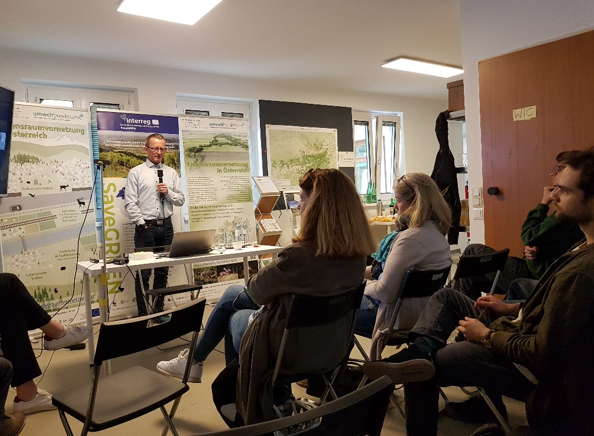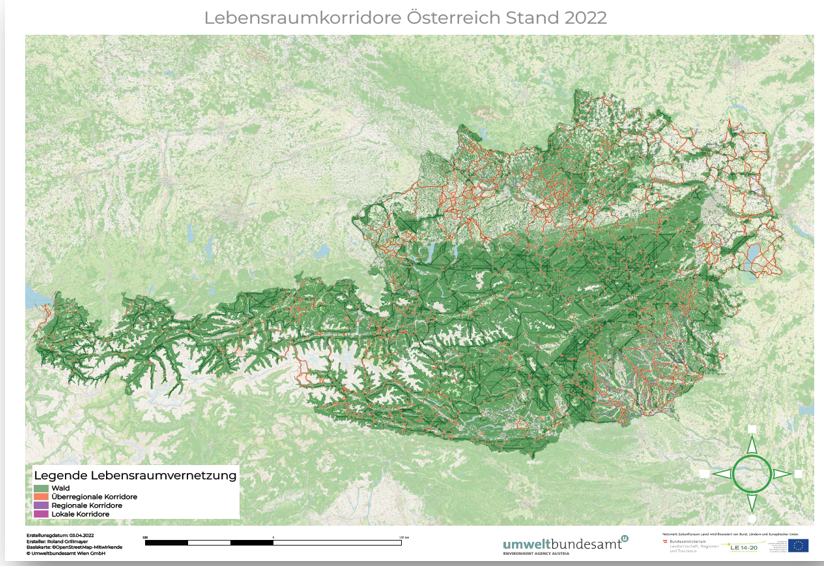SaveGREEN - Capacity building workshop held in Vienna, Austria
08-05-2022
On 28 April 2022, the two Austrian SaveGREEN project partners, the Austrian Environmental Agency, and WWF Central & Eastern Europe, joined forces with the Austrian Society for Landscape Architecture to offer insights into the state of ecological connectivity in Austria today.
The event, held in hybrid fashion, both physically and online, in the premises of the Austrian Society for Landscape Architecture in the centre of Vienna, was attended by 28 people, with representatives from the Ministry of Environment, landscape and spatial planning bureaus, landscape architects, the University of Natural Resources and Life Sciences, and environmental NGOs in the audience.
The event provided an opportunity for fruitful exchanges on crucial topics such as:
- the current status quo of ecological connectivity,
- the perceived needs of actors working on the topic,
- the tools already available and under development.

Image 1.: Roland Grillmayer of the EAA © Hildegard Meyer
To kick off the event, Roland Grillmayer of the Environment Agency Austria (EAA) presented a look back at the rise of ecological connectivity as a topic of growing importance in Austria over the past 20 years, spotlighting the main actors that drove this development, highlighting important pieces of legislation, such as the Organisational Directive issued by the Ministry of Transport in 2006 mandating the construction of 20 new green bridges until 2027, and describing the situation we face today.
A significant challenge is creating a harmonised dataset on ecological connectivity across all 9 federal states in Austria, rendered all the more difficult due to the strong cross-cutting nature of the topic, with a strong division of competences across federal and sectoral lines. Illustrating his point with numerous examples from around the country, Mr. Grillmayer stressed the urgent need for taking rapid action to preserve ecological corridors from further obstruction, particularly in bottleneck areas, where past construction activities and the natural lay of the land leave only a few remaining passages for wildlife to pass through the landscape.
As a continuation, Mr. Grillmayer presented the brand new ‘Guidelines for Assessment of the permeability of ecological corridors’, which were produced by the EAA in collaboration with wildlife ecologists and the Austrian Chamber of Agriculture. The Guidelines, conceived for wild medium- and large-sized mammals (larger than a hare), provide instructions for the assessment of construction projects requiring authorisation, that are planned within ecological corridors. Upon publication, the Guidelines are intended to support the formal environmental evaluations (such as EIAs, SEAs) of such projects.
At this point, Mr. Grillmayer underlined the importance of considering both the structural and functional permeability of ecological corridors, which is where the Guidelines for Standardised Monitoring of Functional Connectivity, being produced as part of the SaveGREEN project, offer useful insights.

Image 2.: Ecological Corridors in Austria, 2022 © EAA
To anchor ecological corridors in special maps spanning the entire country, efforts are currently underway to integrate them into the national Forest Development Plan. These ongoing efforts were presented by Christoph Bauernhansl from the Federal Research Facility on Forests, who showed the participants the first renditions of these special maps. Another representative from the EAA sitting in the audience underlined the importance of this undertaking, given the fact that Austria does not have a national landscape plan for nature conservation.
In his last contribution to the workshop, Mr. Grillmayer presented the Austrian Portal on Ecological Connectivity, which gathers maps, geospatial data and relevant publications on ecological connectivity in one centralised website. The presented tools generated notable interest from the audience, many of whom were unaware of the magnitude and depth of the data available. A representative of a landscape planning bureau confirmed that, from her practitioner’s point of view, increasing the visibility of this data among relevant actors was one of the most important tasks at hand, as she viewed many in her sector as being aware of the topic and willing to consider it in their work, but often lacking sufficiently robust data.
The afternoon’s last session was dedicated to a presentation by Hildegard Meyer of WWF-CEE on the SaveGREEN project and its activities in the two Austrian pilot areas ‘Kobernausser Forest’ and ‘Pöttsching’, followed by a discussion among all those present on the consideration of ecological connectivity in Austrian Environmental Impact Assessments (EIAs) and Strategic Environmental Assessments (SEAs).
The audience members agreed that planning authorities generally took ecological connectivity into account in EIAs dealing with large infrastructure projects, but that the topic was largely lacking in SEAs, where it is strongly dependent on the available data and plays only a marginal part of considerations on endangered species protection, and smaller construction projects, which do not require an EIA. Regarding the important players in the Austrian spatial planning landscape, the audience felt that while the large state-owned enterprises were sufficiently aware of the ecological connectivity as an issue of concern, a key target group for further awareness raising measures were the mayors of Austria’s 2 095 municipalities, who have significant decision-making powers related to spatial planning and zoning decisions. The integration of ecological corridors into spatial plans at all levels of government in Austria, from the municipalities, to the Länder and the federal state, represented another crucial step to increase the visibility of the topic and allow relevant authorities to take it into account when formulated decisions with real spatial implications on the ground.
The workshop ended with a call to all attendees to continue the vital work to preserve ecological connectivity in Austria.
The next action step is to continue the work on the pilot areas and further develop capacities at the upcoming Transnational workshops.
